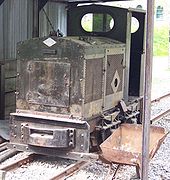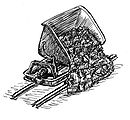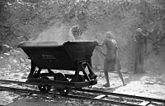Debris track

A rubble train is a rail-bound means of transport that was used to clear rubble in more than 20 German cities after the end of the Second World War . The vehicles used here were primarily the field railways known from peat cuttings or brickworks , as well as freight trams and sometimes standard-gauge railways that were operated on provisionally laid tracks in streets - for example in Berlin. The main task of the rubble railways was the transport of the material leftovers from the previously completely cleared, destroyed buildings. These were driven to large interim storage areas or final storage sites, and the rubble was sometimes used to fill entire (destroyed) streets and make them flood-proof. These trains were often loaded by so-called rubble women .
Cities with rubble tracks
|
|
|
The state archives and city archives of the listed cities have various material, but usually only show this in special exhibitions, such as the German Photo Library in the Saxon State and University Library Dresden , the Museum of Labor in Hamburg - Barmbek or the Historical Museum Hanover in Hanover . The Institute for Urban History in the Carmelite Monastery (Frankfurt am Main) in Frankfurt am Main houses the former Frankfurt City Archives.
Rubble railway in Berlin
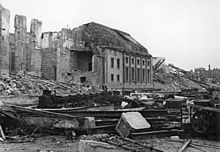
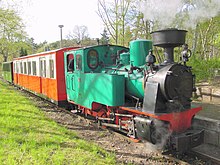
Between 1945 and 1954, at least 89 companies were used on Berlin's streets to clear around 75 million cubic meters of rubble. This was done to a very small extent by horse-drawn carriages , trucks or ships , but mostly by light rail systems on public roads with a total network of 300 kilometers, which was neither temporally nor spatially connected. The longest route was between 1948 and 1953 between the Schlossplatz in Berlin-Mitte and a large dump in Friedrichsfelde with 15 kilometers.
Large amounts of rubble ended up in large repository areas, casually referred to as a dump . The following camps, which still exist today and were mostly integrated into the city as parks, should be mentioned:
- the Teufelsberg in the district of Grunewald , where 26 million cubic meters of the shell of the defense technology faculty was flooded and a 120 m high mountain was created,
- the Humboldthain in the district of Gesundbrunnen , in which the large flak bunker was built up or filled in after being partially blown up,
- the large and small bunker mountain in Volkspark Friedrichshain , also flooded flak towers,
- a former barracks area with the Reichspoststadion , today's Fritz-Schloß-Park in the district Moabit ,
- the Cantianstraße sports field in the Prenzlauer Berg district ,
- the islanders in the south of the Schöneberg district .
Exact research, albeit only 50 years after the end of the war, revealed at least 80 repository sites in the entire Berlin city area and in the immediate vicinity.
For the debris railway goods by those same files more than 37 small steam engines (17-75 hp), more than eleven diesel locomotives, multiple work railcars of tram and a large steam locomotive of the Deutsche Reichsbahn in use. The entire fleet of the field railways was at least eight depots stationed. After the rubble had been removed, i.e. around 1954/1955, a remaining rubble railway line in what was then East Berlin was used for around three years as a construction line to transport the building material for the new construction of what was then Stalinallee (now Karl-Marx-Allee ).
In a small exhibition, the Berliner Unterwelten e. V. an original goods cart . A steam locomotive, probably also from the machines used to clear rubble, was reconditioned on the occasion of the 750th anniversary of Berlin and is now running on the park railway line in Wuhlheide .
Rubble railway in Freiburg im Breisgau
In Freiburg im Breisgau there was a 2.6 kilometer long rubble railway from 1947 to 1949, which carried the rubble from the institute quarter via the Stühlinger to the Flückigersee in the west of the city.
Rubble railways in Hamburg
In Hamburg , from 1945 to 1954, a field railway with lorries drove from the rubble reloading point east in the Hamm district (today's Thörls Park at the western end of Hirtenstrasse) through the Horn and Billstedt districts to the gravel works in Öjendorf . The route ran through the streets of Hirtenstrasse - Bei der Hammer Kirche - Horner Weg - Hermannstal - Kattensteert - Schiffbeker Höhe - Öjendorfer Weg Further course: across the fields east and west of Mattkamp, in a large curve over the eastern area of the former gravel works to to its northern end. The gravel plant was later converted with the heaps of rubble to the Öjendorfer Park , which adjoins the Öjendorf cemetery to the east .
Another rubble train ran from the West transshipment facility on the Eimsbüttel market square to Eidelstedt (Eimsbüttel market square - Pinneberger Weg - Övelgönner Straße - Langenfelder Straße - Waidmannstraße - Leunastraße - Winsberg - Volkspark) until 1951 . On the edge of the Altonaer Volkspark , a debris pile was created that was covered with topsoil and reforested. Some of the rubble was used to build the Volksparkstadion .
Rubble railways in Leipzig
The approximately seven million cubic meters of rubble from around 10,000 totally destroyed and 26,000 more or less damaged buildings, from the mostly destroyed exhibition halls and halls as well as the numerous defective production facilities, were removed in Leipzig from 1945 mainly by debris railways based on light railways with three separate track systems, the Südbahn , the Zentrumsbahn and the Nordbahn , whereby the last two were organizationally connected.
The southern runway covered the southern parts of the city , which were particularly hard hit in the bombing of December 4, 1943 . Its track network extended from Emilienstraße in the north to Waisenhausstraße (today Arno-Nitzsche-Straße) in the south and from Lößniger Straße in the east to Fockestraße in the west. It was initially transported via Waisenhausstrasse and Zwickauer Strasse in Marienbrunn to the landfill on the quarry fields of the Dölitz coal mine in Dosen . This long transport was replaced in the autumn of 1947 by a new landfill, which was built on a piece of forest in Connewitzer Holz, the Bauernwiesen, which was devastated by bombs and was later called Fockeberg .
The Zentrumsbahn disposed of the city center and here initially the large mountains of rubble on Augustus-, Roß- and Wilhelm-Leuschner-Platz , which had been piled up from the rubble of the city center from 1944 onwards. The landfill targets were the Johannisthal on Hospitalstrasse (today Prager Strasse) but also the Möckern landfill , which was reached via a track along the Elster basin . From 1947 the farm meadows were also approached, with the music district being cleared.
The Nordbahn did not start operating in the area around Nordplatz until the end of 1947 and transported the rubble to a place on Cottaweg, where the oval of a cycle track was to be heaped up, but which was never completed. From 1950 rubble was used for the construction of the swimming stadium and the central stadium on the Frankfurt Meadows.
The rubble railways were initially operated by private construction companies, the southern railroad by a working group Weißflog KG / Otto Schwabach and the central railroad by Sager & Woerner , and after their expropriation in 1946 by municipal companies. The vehicle fleet for the Zentrumsbahn consisted of 16 steam locomotives, twelve diesel locomotives and 552 lorries with a capacity of between 0.75 and 1.5 cubic meters in the year of its strongest stocking in 1946. On Wilhelm-Leuschner-Platz there was a depot for the maintenance of the rolling stock, where repairs and conversions were carried out. In 1949 the Südbahn had six steam and two diesel locomotives as well as 155 lorries and four plate wagons. The rubble railways in Leipzig existed until around 1955.
In addition to the field railways, trams were also used to transport rubble in Leipzig in the early years.
Debris railway in Magdeburg
The old town of Magdeburg around what was then Deutsche Platz (later Universitätsplatz) was largely destroyed at the end of the war in May 1945, according to initial estimates, 80 percent. The reinstated city administration launched a competition for reconstruction, organized an exhibition Magdeburg Lives and commissioned companies to remove the first ruins, which also installed field railways here to transport the accumulating material. The photo from the Federal Archives (see introduction) shows a locomotive of the rubble railway whose route network ran across this square. The city archive also has further images of the rubble railway from the photographer of the photo, Wilhelm Biscan. The rubble railway apparently served to transport rubble, bricks and iron parts until 1954. Many students from what was then the University of Heavy Engineering (later Otto von Guericke University ) took part in the work.
From 1955, locomotives of the rubble railway were also in use on the Magdeburg pioneer railway.
Debris railway in Münster
Construction experts estimated the amount of rubble caused by the war, especially in the center of Münster, at around 2.5 million tons . This rubble was transported to facilities outside the city on a field railway, which was laid and operated by the Peter Büscher company. The Hindenburgplatz not yet been served at that time as a garbage dump for the interim storage of evacuated from the city center transported away debris masses. The locomotives and wagons from the manufacturer Orenstein & Koppel were in use from 1946 to 1960. In 1961, Büscher gave the city a decommissioned transport locomotive that was used for a long time as play equipment on the Coerdeplatz playground. In 2003, the tractor has been thoroughly reconstructed and in August 2004 as a memento parked in the lime market.
Rubble railway in Nuremberg
Debris railway in Ulm
The following (slightly abbreviated) report can be found in an Internet forum: “During the week of oaths from 6 to 15 August 1949, the 'Ulm Spatzen Railway' ran. The 1.5 km long steam train was part of the 600 mm rubble railway between the city center and Friedrichsau, which existed from 1946 to 1950. While the building contractor Baresel provided three steam locomotives, ten lorries (with walls and seats) and the driving staff, the tram took care of operations management and supervision. A total of two trains with five cars each ran between the Valckenburghufer station on Münchner Strasse at the Gänstorbrücke and Ausee station. The route followed the northwestern Valckenburgufer, then the southeast edge of the Gänswiesenweg, where after 850 meters the intermediate station Festwiese with a siding was located, and further along the Danube to Friedrichsau. ”- Whether the rubble was reloaded onto ships or stored directly on the Danube, is not known.
Debris railway in Zerbst
In Zerbst, a rubble railway was used from 1947 to 1952, which transported a total of 372,000 cubic meters of rubble from the center to an artificial mountain.
Rubble railway in Zweibrücken
In Zweibrücken , the city center was completely destroyed in an air raid on March 14, 1945. A field railway from the Oltsch construction company equipped with tipping platforms cleared the rubble. The streets and squares of the city were filled with the rubble, raising the level by about one meter. There are some photo evidence of these activities from the Federal Image Archive.
Rubble railway on Heligoland
The North Sea island of Helgoland was developed as a fortress during the Second World War. When the war was over, the victorious power of Great Britain confiscated this island, systematically destroyed it and used it for bomb-dropping exercises . When the island was returned to Germany in 1952, nothing was left of the buildings and defenses. The island itself was also no longer habitable. Former residents and the responsible administrations made sure that the rubble could be cleared with a small field railway including wagons. Soon afterwards, the first Heligoland returned to their island and gradually made it habitable again.
Special features of the railway systems
The rubble railways installed after the war in 1945 did not have a uniform type of railroad. The systems and vehicles that were currently available and suitable were used for the rubble removal. For the most part, these were the quick-to-install and technically simple light rail locomotives, with narrow-gauge tracks with a gauge of 500, 600, 750 or 900 millimeters.
The switches were mostly set manually. Crossing adapters for crossing existing track systems were placed or removed by helpers as required, and the vehicles were stopped at level crossings or road crossings with flag signals.
Occasionally, also were working car of the tram used on the existing railway tracks for debris transport, separate rail material or special signaling systems were usually not required. For loading, however, special ramps were set up on which the small wagons of the field railways were pushed in order to then empty their contents onto the larger tram cars.
In Berlin, a standard-gauge railway was used as a rubble railway on a route length of around two kilometers . Their tracks were also laid on the street on their own graveled dams and secured with metal fences on both sides. This line had a direct connection to the rail network in the area of the central cattle yard , at the other end of the line there was a longer ramp for reloading the rubble from the carts.
Depots were set up on larger open spaces for the rolling stock . The fleet of vehicles was maintained, repaired and made ready for operation in fenced and guarded areas , and from here the deployment was coordinated and the goods and quantities transported were settled.
vehicles
Steam locomotives
Small steam locomotives dominated the field railways because coal was the easiest to operate. There were also individual conversions so that coke or brown coal could be used. Their manufacturers were for example Jung , Henschel , Orenstein & Koppel (O&K), Krauss-Maffei , BMAG Schwartzkopf.
Diesel locomotives
Small diesel locomotives, again mainly from German manufacturers such as Deutz , Henschel, O&K or Schöma , were used on smaller roads or on smaller inclines, but the provision of the required diesel fuel was often a problem.
Trams
Work cars and towing cars were used as tractors for trams . In 1948 the Berliner Verkehrsgesellschaft (BVG) removed 368,000 tons of rubble as part of the rubble removal, mainly in the first half of the year. For this purpose, special tracks were laid to a rubble loading ramp (reloading onto barges) on the Spree opposite the cathedral in the almost completely destroyed city center .
dare
The most important components of the rubble railway were the cargo wagons. The open field railroad cars or lorries played the most important role here. The companies commissioned with the rubble removal used all available trucks, which resulted in a great variety, both in terms of design, size and years of construction. Between 10 and 15 fully loaded lorries were carried by the tractor units. In addition to the carts, platform wagons were used to transport beams, iron girders and other bulky material.
A car of the Würzburg rubble railway
literature
- Angela M. Arnold (Ed.): Trümmerbahn and Trümmerfrauen . OMNIS Verlag, Berlin 1999, ISBN 3-933175-57-7
- Angela M. Arnold, Gabriele von Griesheim: rubble, railways and districts. Berlin 1945–1955 . Self-published, Berlin 2002, ISBN 3-00-009839-9
- Werner Bendix: Phoenix from the ashes. Frankfurt's rise to the 'economic capital', 1945–1956. In: Dieter Rebentisch (Ed.): Archive for Frankfurt's history and art. Vol. 67 (2001), pp. 61-100
- Christoph Kaufmann: Through the city at full speed. The Leipzig rubble railways 1944–1956. Lehmstedt Verlag, Leipzig 2006, ISBN 3-937146-36-9
- Markus Pöhlmann : Trümmerbahn , in: Stadtlexikon Augsburg (online) from September 3, 2010.
- Klaus Scherff: rubble railways. transpress, Stuttgart 2002, ISBN 3-613-71197-4
Web links
- Wreckage locomotive number 44 on the Wuhlheide Park Railway (Berlin). In: parkeisenbahn.de. Retrieved February 1, 2013 . T
- Debris railway in the Stadtwiki Karlsruhe
- Private homepage with photos and information about rubble railways in Germany
Individual evidence
- ^ Axel Deubner: Debris railways and debris recovery. (No longer available online.) In: Unser-aachen.eu. Archived from the original on August 27, 2011 ; accessed on February 1, 2013 (literature, newspaper and contemporary witness reports on the three routes of a TB in Aachen).
- ^ Wolfgang Eilers, Dietmar Falk: Narrow-gauge steam in Braunschweig. The history of the rubble railway , In: Small series of the Braunschweiger Verkehrsfreunde e. V. , Volume 3, Braunschweig 1985
- ↑ Peter Engels: Rubble clearance and recycling. In: Stadtlexikon Darmstadt. Historical Association for Hessen eV, accessed on April 13, 2020 .
- ↑ Volker Unruh (Ed.): The Erfurt tram as a snippet on books.google.de; Sutton Publishing, 2008; Page 8; accessed on February 1, 2014
- ↑ Stühlinger Online. January 2, 2013, archived from the original on July 8, 2004 ; retrieved on February 1, 2013 : "Only the rubble railway brought the rubble from the institute quarter to the gravel works"
- ↑ Website for the Mayener rubble locomotive: http://www.feldbahn.com/dampflok.htm
- ↑ Rubble upon rubble. Clearing the streets is difficult progress - a small train enables transport to the Bötzinger Tal . ( Page no longer available , search in web archives ) (PDF; 281 kB), Series Pforzheim on the way to the new city; Episode 18: 'Rubble for Reconstruction' by Thomas Frei, In: Pforzheimer Zeitung No. 269 of November 20, 2010; Retrieved February 6, 2012
- ↑ Angela M. Arnold (Ed.): Trümmerbahn and Trümmerfrauen . OMNIS-Verlag 1999, 214 pages, 118 illustrations.
- ↑ Angela M. Arnold, Gabriele von Griesheim: rubble, railways and districts. Berlin 1945-1955 . Self-published 2002, 288 pages, 148 illustrations, ISBN 3-00-009839-9 .
- ↑ Exhibition: where the rubble train drove . In: Berliner Zeitung , January 18, 2000.
- ^ Atlas for Hamburg Schools , 1954 edition, Georg Westermann Verlag, pp. 3 and 5.
- ↑ Kerstin von Stürmer: You cleared the rubble in record time . ( Abendblatt.de [accessed on March 15, 2018]).
- ↑ Christoph Kaufmann: Full steam through the city. The Leipzig rubble railways 1944–1956.
- ↑ Everyday life in ruins. Leipzig 1945-1949. Documents, letters, diary entries and photographs from a turbulent time . DZA Verlag for Culture and Science, 1995
- ^ Literature: Urban development in Magdeburg 1945–1995. Plans and documents (pdf)
- ↑ Answer of the city archive to a request regarding the photo shown in the introduction
- ↑ Nine photos from the archive of Magdeburg University to clear out rubble in downtown Magdeburg. , accessed December 20, 2014.
- ^ Magdeburg Pioneer Railway; Forum
-
^ Rubble locomotive in Münster ;
Between the end and the beginning. Themed evening in the city archive with photos from 1945 to 1949 , May 22, 2015; accessed on September 23, 2015. - ↑ The Ulmer Spatzen-Eisenbahn from 1949 on Drehscheibe-online.de
- ^ Rubble railway steam locomotive in Ulm 1948; Photo from the archive (PDF; 65 kB)
- ↑ Private homepage about the destruction in "Alt-Zerbst"
- ↑ The Zerbster Rubble Railway at www.alt-zerbst; accessed on March 26, 2014
- ↑ Hamburger Abendblatt: They cleared the rubble away in record time ( page no longer accessible , search in web archives ) Info: The link was automatically marked as defective. Please check the link according to the instructions and then remove this notice.





